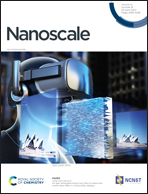Tunable in-plane thermal conductivity of a single PEDOT:PSS nanotube†
Abstract
Understanding the mechanism of thermal energy transport in a single nanotube (NT) is essential for successfully engineering nanostructured conducting polymers to apply to thermoelectrics or flexible electronic devices. We report the characterization of the in-plane thermal energy transport in a single poly(3,4-ethylenedioxythiophene) polystyrene sulfonate (PEDOT:PSS) NT via direct measurement of the in-plane thermal conductivity (κ). We also demonstrate that the in-plane κ of PEDOT:PSS NT can be tuned within the range of 0.19 to 1.92 W·m−1·K−1 merely by changing the solvent used to treat the NTs in the post-fabrication stage. The in-plane thermal energy transport in a pristine NT, with its low in-plane κ, is primarily due to phonons; in a sulfuric acid-treated NT however, significant electronic contributions lead to a high in-plane κ. The present study will contribute to understanding the mechanism of thermal energy transport in highly disordered structures, such as conducting polymers, and to designing highly efficient polymer-based devices in which in-plane κ plays a pivotal role in determining the energy conversion efficiency.



 Please wait while we load your content...
Please wait while we load your content...